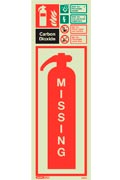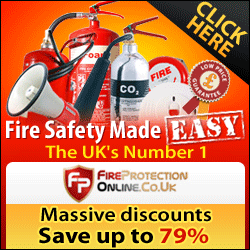 You may have the best quality, shiniest fire extinguishers in your business premises, but they will only be effective if your staff can find them when they need them most! Fire safety equipment signs are a vital part of your fire safety provision for your office, factory, warehouse, hotel, shop, or outdoor site.
You may have the best quality, shiniest fire extinguishers in your business premises, but they will only be effective if your staff can find them when they need them most! Fire safety equipment signs are a vital part of your fire safety provision for your office, factory, warehouse, hotel, shop, or outdoor site.
Fire Safety Signs: What the Law Says
Health and Safety regulations require all owners of premises to use safety signs, quote, “Where there is a significant risk to health and safety that has not been avoided or controlled by the methods required under other relevant law, provided the use of a sign can help reduce the risk.”
All signs also need to conform to the British Standard Code of Practice for safety signs (BS 5499-10:2006)
Seeing Red: Fire Extinguisher Safety Signs
All fire equipment signs feature a red background with white graphics. These familiar red signs indicate where you and your colleagues can find fire extinguishers and other firefighting equipment, such as fire hoses or breathing apparatus.
Fire extinguisher signs often combine vital information for users on one easy-to read sign. For example, a combination sign might include:
- a red fire equipment sign for an extinguisher at the top
- a blue information sign detailing the extinguisher type
- green information symbols indicating the types of fire the extinguisher can be used on
So, your fire extinguisher sign can be a ‘one-stop shop’ of vital information in an emergency. Now you need to ensure everyone can see it!
Fire Safety Sign Placement
Placing your signs in the right places can give you staff vital extra seconds in an emergency. Make sure that every fire extinguisher has an appropriate sign not just at extinguisher level, but at eye level as well. Remember that not everyone is the same height, so eye level for some is sky level for others! Also consider the needs of any disabled members of staff, whose eye-line may be different again.
Always place your fire extinguishers where they can easily be accessed, and their associated fire safety sign can be seen at all times, so don’t site them behind a door or near a coat rack, for example.
If you have new premises or are renovating your old offices, your local Fire Officer or a professional fire risk assessor will be happy to help with advice on correct and effective placement.
Fire Extinguisher Stands and Signs
 Despite modern advances in technology, fire extinguishers are still heavy items. Modern office partition walls and old brick walls in older premises may not be robust enough to support the weight of an extinguisher mounted on the wall. A better option is a fire extinguisher stand , which also protects your fire extinguishers from accidental knocks.
Despite modern advances in technology, fire extinguishers are still heavy items. Modern office partition walls and old brick walls in older premises may not be robust enough to support the weight of an extinguisher mounted on the wall. A better option is a fire extinguisher stand , which also protects your fire extinguishers from accidental knocks.
These red, grey or cream rigid plastic floor stands give your extinguishers a safe and sturdy home, and protect your carpets too! For external use, tough steel frame Fire Point stands are also available.
Walking Fire Extinguishers: Do They Exist?
 From the number of times office fire extinguishers seem to move from their original positions to prop open doors, etc, you might be forgiven for thinking they had legs! Fire extinguisher signs can help you instantly identify any gaps, as some designs feature a “Missing” graphic.
From the number of times office fire extinguishers seem to move from their original positions to prop open doors, etc, you might be forgiven for thinking they had legs! Fire extinguisher signs can help you instantly identify any gaps, as some designs feature a “Missing” graphic.
Simply place your extinguisher in front of the graphic, and if the extinguisher is subsequently moved, you’ll see “Missing” in large letters.




Recent Comments